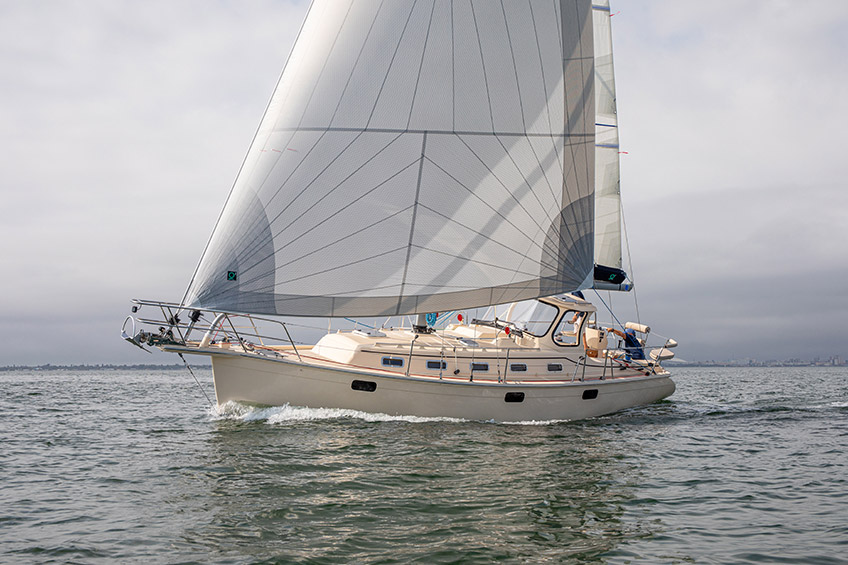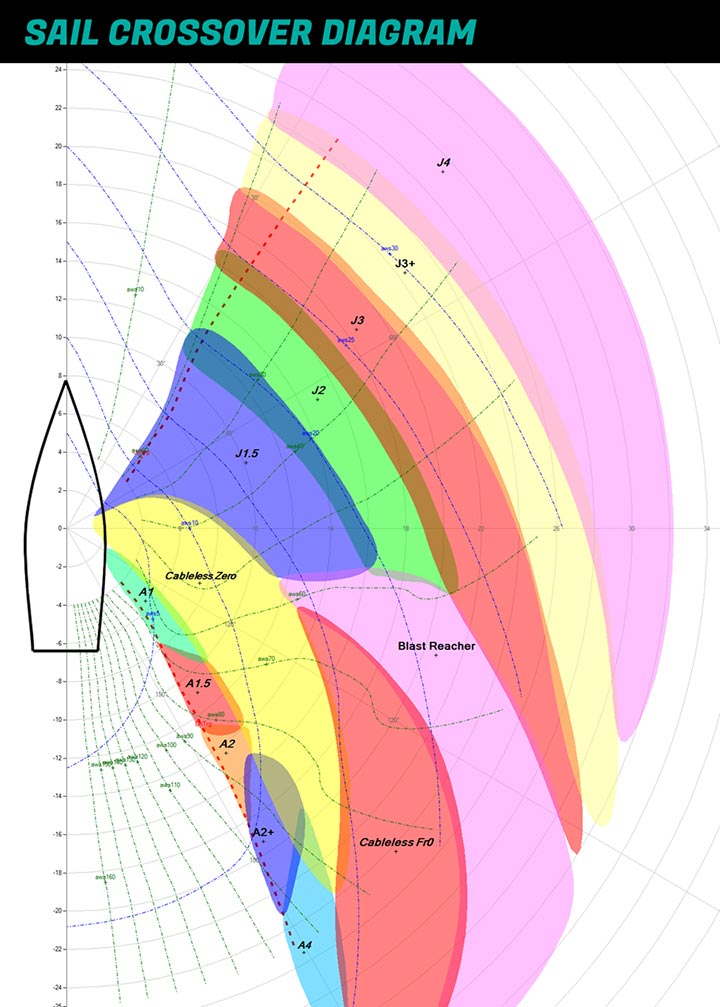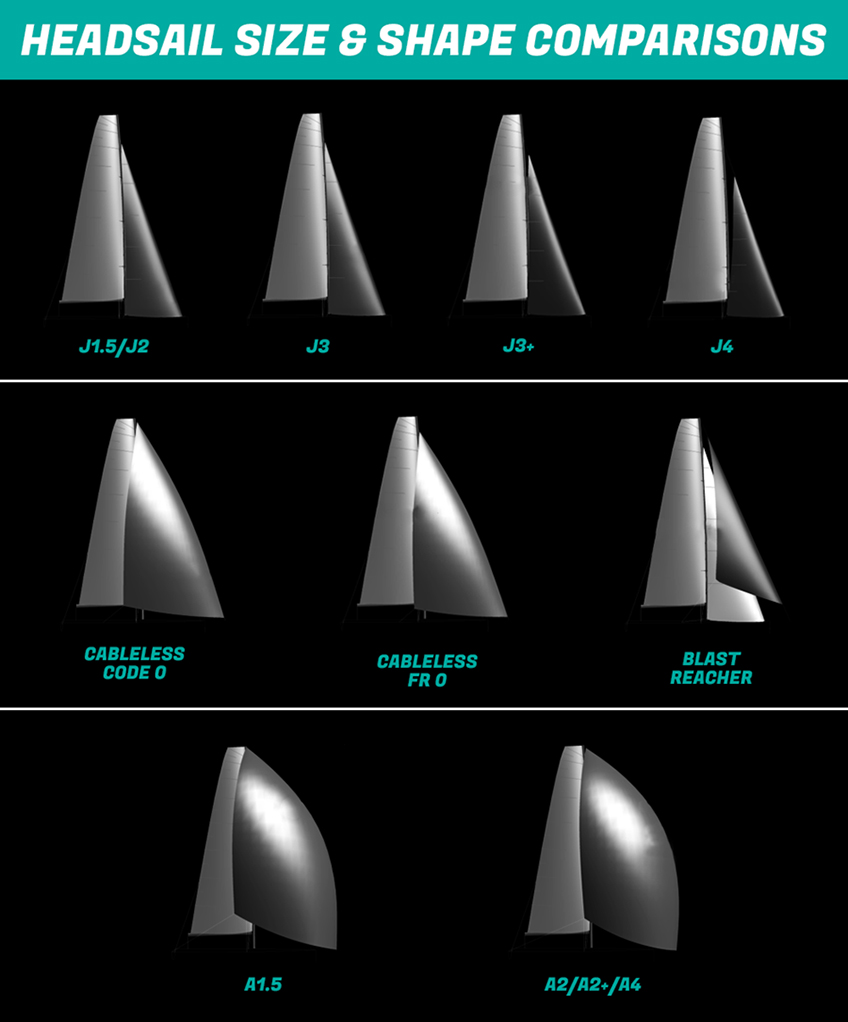Having the right headsail for the job is important. In this article, Quantum experts break down the different headsails that may make up your sail inventory.

Many factors determine the best headsail inventory for you: the type of sailing you do, the conditions you typically sail in, and the design, size, and shape of your boat. You’ll also need a mix of sails that can perform at upwind, reaching, and downwind angles. Upwind sails optimize lift at the tightest angles to the wind; reaching sails optimize driving force across the wind; and downwind sails optimize drive when in “push mode.” Understanding how air flows across the sails helps to explain why sails are cut and sized differently for those angles and will help to inform the best usage of each headsail.
Most boats won’t have all the headsails listed in this article, and inventories can differ drastically from boat to boat. While we’re focused on headsails for racing in this article, whether you’re a racer or a cruiser, understanding the differences in headsails will help you optimize your inventory for the kind of sailing you do.
Upwind Headsails
The ability to create lift through efficient sail shape is paramount for an upwind headsail. As with the mainsail, lift is generated when the camber, or curve of the sail, creates smooth but differing air flow speed on the windward and leeward sides of the sail. In different apparent wind speeds and angles, different sail sizes and shapes are needed to keep the boat at its optimal angle of heel and speed. As a rule of thumb, deeper sails create a driving force that is more aft (lower lift/drag ratio), and flatter sails create a driving force that is angled closer to the wind (higher lift/drag ratio). All sails create some drag that pulls the yacht sideways that the keel must counter. The ability to balance side force versus driving force is the secret to a well-designed sail.
Upwind headsails go through a narrow range of apparent wind angles, but they see the greatest change in apparent wind speed of any of the sails. Because of this change, what works best in five knots of wind speed will not be your best sail option in 25 knots of wind speed. When racing, upwind headsails are limited in area to keep a yacht’s handicap rating from becoming too high. For this reason, in lighter winds they don’t make good reaching sails. When rating isn’t in play, you can combine a few upwind and reaching sails for better performance. In a perfect world, yachts would have multiple rigs, much like windsurfers or 18-foot skiffs, and these rigs would have sails that are appropriately sized with depths for optimum performance in a given wind speed. But we don’t live (or sail) in a perfect world, so all yachts go through a transition upwind from being underpowered to having too much sail area. You will need to find ways to increase power with smaller sails and then reduce sail. The ability to change headsails is the most efficient way to accomplish this.
If your headsail is large enough to overlap part of the mainsail, it is classified as a genoa. Light genoas, or G1s and Number 1s, are designed to be deep and powerful in lighter winds to maximize drive, even at the expense of added drag and side force. Similar to a Number 1 genoa, the lighter jibs are designed to produce as much power as possible. But as the wind increases, these sails become overly powerful and create too much side force, and you will need to flatten the sails. Your J2 or medium jib/genoa will still give you an efficient sail shape at maximum area. Once the wind speed increases, you cannot flatten a sail enough while maintaining efficiency, so you must reduce sail area. Some yachts will have several heavy air specialty sails that get smaller and smaller, though most yachts with genoas will switch to J3, J3.5, J4, and J5 jibs. As the numbers increase, the sail size decreases.
A note on cruising upwind headsails:
A typical upwind cruising headsail inventory may contain a J1, J2, and J3, or more frequently, only one upwind headsail, which makes sense since cruisers are often sailing short-handed or with crew who have a mixed bag of skill levels. Cruisers tend to rely more on furling to depower rather than switching to a smaller or flatter sail. For this reason, cruising sails are designed with furling in mind so sails can perform up-range yet still maintain desired sail shape and performance when furled. Stay tuned for a follow-up article that shares information on headsails designed for cruising.
Reaching Sails
When sailing upwind or downwind, you can find an optimal angle that balances speed with velocity made good (VMG), but when reaching you want to go as fast as possible across the wind toward your next mark or waypoint. Therefore, reaching sails must be designed and built to accommodate for this difference. One similarity reaching sails have with upwind headsails is that they transition quickly from not having enough power to having too much power as the wind speed increases. Reaching sails also see a variety of both apparent wind angles and apparent wind speeds. In some wind speeds, a spinnaker can work for reaching, but the boat will perform better at that angle if you change the area and shape of the sail. Many asymmetrical spinnakers will also overpower you in heavier air at reaching angles.
 This crossover chart is meant to show all the different headsail options and their optimum ranges. Your sail crossover chart will vary based on your boat and the type of sailing you do.
This crossover chart is meant to show all the different headsail options and their optimum ranges. Your sail crossover chart will vary based on your boat and the type of sailing you do.
While we prefer to use specialty reaching sails, some racing rules require only jibs or asymmetrical spinnakers. The problem with using downwind sails while reaching is related to materials, loads, and apparent wind angles. New materials aren't as fragile as they once were but reaching with sails not designed for the increased loads of sailing at these angles can be problematic. There is so much corner load when reaching that sails built for reaching need to be reinforced with stronger materials. As you start to reach closer to the wind direction, your apparent wind speed increases rapidly. This also increases the heeling movement sails produce, which is typically the limiting factor in determining which reaching sail you can use. Unlike headsails that you can luff, a free-flying headsail such as an asymmetric spinnaker will just flap if you try to sail it too high. If you could fill the sail, it would generate too much side force because it is optimized to drag a yacht downwind. When reaching, we want a sail that is more wing-shaped and can drive the yacht forward, not backward.
CODE ZEROS/AWA 40, AWA 60, AWA 80
A solution to the materials, loads, and apparent wind angles equation lies with specialty reaching sails. Often referred to as code zeros or AWA sails, these sails are designed to cover a wide range of reaching angles. While classified under most rating rules as a spinnaker or downwind sail, codes and AWAs are flat enough to handle points of sail closer to the wind without excessive drag. Because of their wide range of angles, AWAs and code zeros are a useful tool for bridging the gap between downwind and upwind sails. AWA sails and code zeros are often used in both racing and cruising inventories. There are also plenty of other specialty reaching headsail options such as wind seekers, jib top reachers, blast reachers, genoa staysails, and spinnaker staysails that can be used to complement code zeros, AWA sails, and spinnakers. These sails are typically used in larger racing inventories.
Downwind Sails
Downwind headsails are generally made for “push mode,” meaning they’re built with more curve to enhance driving force when sailing with the breeze. Downwind symmetrical kites can sail deep angles as the wind is meant to flow into them and then separate and create as much drag as possible, unlike asymmetrical kites that, similar to reaching sails, allow the wind to flow across the sail to create more lift.
ASYMMETRICAL KITES
Now we’re focusing on yachts carrying asymmetrical kites. A downwind sail’s main purpose is to allow a yacht to sail its optimal VMG angle downwind as fast as possible. Like upwind sails, the area of the sail will be limited when racing ratings are in play to achieve a more favorable rating. A larger kite will go faster downwind until its geometry becomes too deep and wide. Yachts are usually rated for the optimal area for lighter air kites. Heavier air kites are sometimes slightly smaller than you would make in absence of any rules because most yachts spend the majority of their time racing in 12 knots or less. In lighter winds, the best wind angle will always be to sail higher than dead downwind to increase apparent wind speed, which allows the yacht to transfer as much kinetic energy from the wind as possible. By sailing higher angles in lighter wind, you can double your apparent wind speed and increase the power your yacht harnesses from the wind by almost four times while sailing only 15 percent more distance.
As your apparent wind speed increases and your sail angles tighten, your apparent wind angle decreases. Lighter air kites made of lighter cloth and flatter shapes operate in narrower apparent wind angles and have less apparent wind speed than heavy air kites. As you sail wider angles, optimum depth for your kite increases as the wider apparent wind angle acts to push the yacht, making a deeper sail more efficient. Lighter yachts that sail across the wind because they can sail faster speeds tend to have flatter kites compared to yachts that are heavier and sail more directly downwind.

DETERMINING HEADSAIL OPTIONS
Many factors go into selecting the perfect headsail, among them rig type, typical conditions, typical wind range, type of sailing, and racing ratings. Take time to assess these variables and what types of headsails will best serve you upwind, downwind, and reaching. If you have questions or would like help making a sail plan, give your local loft a call. Quantum experts can expand on any of the headsails in this article and help determine where the gaps in your inventory may be. But be prepared: You might discover your new secret weapon!